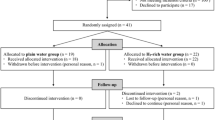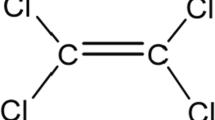Abstract
The generation of reactive oxygen species is thought to cause extensive oxidative damage to various biomolecules such as DNA, RNA, and protein. In this study, the preventive, suppressive, and protective effects of in vitro supplementation with electrolyzed-reduced water on H2O2-induced DNA damage in human lymphocytes were examined using a comet assay. Pretreatment, cotreatment, and posttreatment with electrolyzed-reduced water enhanced human lymphocyte resistance to the DNA strand breaks induced by H2O2 in vitro. Moreover, electrolyzed-reduced water was much more effective than diethylpyrocarbonate-treated water in preventing total RNA degradation at 4 and 25°C. In addition, electrolyzed-reduced water completely prevented the oxidative cleavage of horseradish peroxidase, as determined using sodium dodecyl sulfate-polyacrylamide gels. Enhancement of the antioxidant activity of ascorbic acid dissolved in electrolyzed-reduced water was about threefold that of ascorbic acid dissolved in nonelectrolyzed deionized water, as measured by a xanthine-xanthine oxidase superoxide scavenging assay system, suggesting an inhibitory effect of electrolyzed-reduced water on the oxidation of ascorbic acid.
Similar content being viewed by others
References
Ryoo, K. K., Kang, B. D., and Sumita, O. (2002), J. Mater. Res. 17, 1298–1304.
Park, C. M., Hung, Y. C., Lin, C. S., and Brackett, R. E. (2005), J. Food Prot. 68, 986–990
Bialka, K. L., Demirci, A., Knabel, S. J., Patterson, P. H., and Puri, V. M. (2004), Poult. Sci. 83, 2071–2078.
Koseki, S., Isobe, S., and Itoh, K. (2004), J. Food Prot. 67, 2544–2549.
Ichihara, T., Fujii, G., Eda, T., Sasaki, M., and Ueda, Y. (2004), Kyobu Geka 57, 1110–1112.
Koseki, S., Yoshida, K., Isobe, S., and Itoh, K. (2004), J. Food Prot. 67, 1247–1251.
Koseki, S., Yoshida, K., Kamitani, Y., and Itoh, K. (2003), J. Food Prot. 66, 2010–2016.
Fabrizio, K. A., Sharma, R. R., Demirci, A., and Cutter, C. N. (2002), Poult. Sci. 81, 1598–1605.
Park, H., Hung, Y. C., and Brackett, R. E. (2002), Int. J. Food Microbiol. 30, 77–83.
Lee, J. H., Rhee, P. L., Kim, J. H., et al. (2004), J. Gastroenterol. Hepatol. 19, 897–903.
Kohno, S., Kawata, T., Kaku, M., et al. (2004), Jpn. J. Infect. Dis. 57, 52–54.
Mori, Y., Komatsu, S., and Hata, Y. (1997), Odontology 84, 619–626.
Shirahata, S., Kabayama, S., Nakano, M., et al. (1997), Biochem. Biophys. Res. Commun. 234, 269–274.
Nishimura, L. Y., Teruya, T., Maki, K., et al. (2002), Cytotechnology 40, 139–149.
Ryoo, K. K., Lee, Y. B., Lee, J. K., and Lee, M. Y. (2005), J. Korean Acad. Ind. Soc. 6, 87–93.
Park, E. J., Ryoo, K. K., Lee, Y. B., Lee, J. K., and Lee, M. Y. (2005), J Korean Soc. Appl. Biol. Chem. 48, 155–160.
Singh, P. N., McCoy, M. T., Tice, R. R., and Schneider, E. L. (1988), Exp. Cell Res. 175, 184–191.
Laemmli, U. K. (1970), Nature 227, 680–685.
Nishikimi, M., Appaji, N., and Yagi, K. (1972), Biochem. Biophys. Res. Commun. 46, 849–854.
Horváthová, E., Slamenová, D., Hlincíková, L., Mandal, T. K., Gábelová, A., and Collins, A. R. (1998), Mutat. Res. 409, 163–171.
Cotelle, S. and Férard, J. F. (1999), Environ. Mol. Mutagen. 34, 246–255.
Wu, L. T., Chu, C. C., Chung, J. G., et al. (2004), Mutat. Res. 556, 75–82.
Machado, M. P., Filho, E. R., Terezan, A. P., Ribeiro, L. R., and Mantovani, M. S., (2005), Toxicol. In Vitro 19, 533–539.
Azqueta, A., Pachón, G., Cascante, M., Creppy, E., and López de Cerain, A. (2005), Mutagenesis 20, 165–171.
Park, Y. K., Park, E. J., Kim, J. S., and Kang, M. H. (2003), Mutat. Res. 529, 77–86.
Yen, G. C., Hung, Y. L., and Hsieh, C. L. (2000), Food Chem. Toxicol. 38, 747–754.
Chakraborty, S., Roy, M., and Bhattacharya, R. K. (2004), J. Environ. Pathol. Toxicol. Oncol. 23, 215–226.
Sambrook, J., Fritsch, E. F., and Maniatis, T. (1989), Molecular Cloning, pp. 7.3–7.5. (Ford, N., Nolan, C., and Ferguson, M., eds.). Cold Spring Harbor Laboratory Press, Cold Spring Harbor, NY.
Kim, K., Rhee, S. G., and Stadtman, E. R. (1985), J. Biol. Chem. 260, 15,394–15,397.
Lee, M. Y. and Kim, S. S. (1998), Phytochemistry 49, 23–27.
Podmore, I. D., Griffiths, H. R., Herbert, K. E., Mistry, N., Mistry, P., and Lunec, J. (1998), Nature 392, 559.
Lee, S. H., Oe, T., and Blair, I. A. (2001), Science 1292, 2083–2086.
Author information
Authors and Affiliations
Corresponding author
Rights and permissions
About this article
Cite this article
Lee, M.Y., Kim, Y.K., Ryoo, K.K. et al. Electrolyzed-reduced water protects against oxidative damage to DNA, RNA, and protein. Appl Biochem Biotechnol 135, 133–144 (2006). https://doi.org/10.1385/ABAB:135:2:133
Received:
Revised:
Accepted:
Published:
Issue Date:
DOI: https://doi.org/10.1385/ABAB:135:2:133




